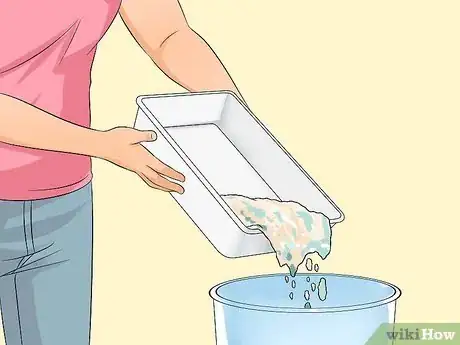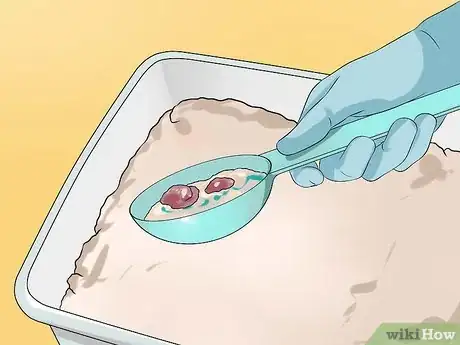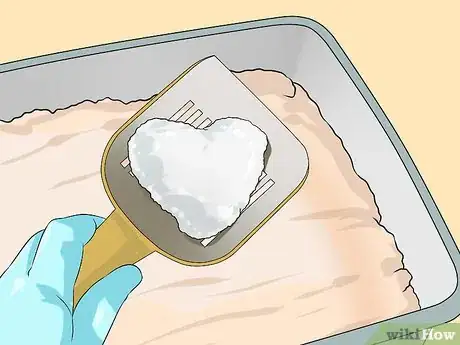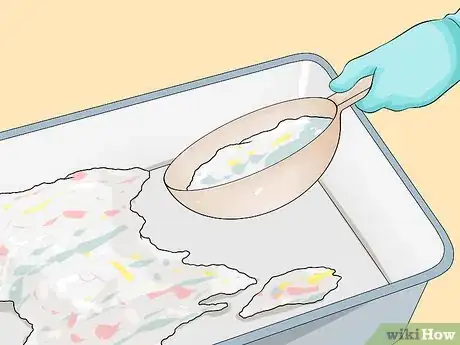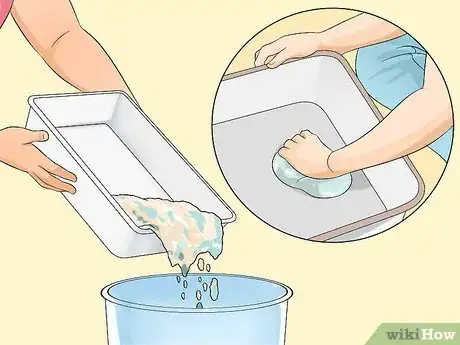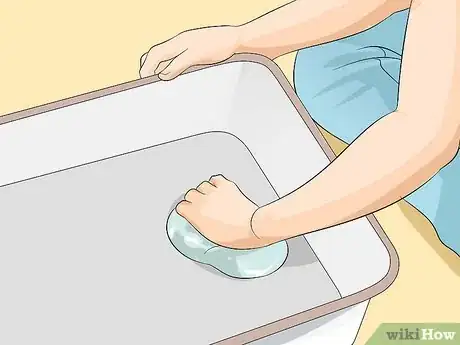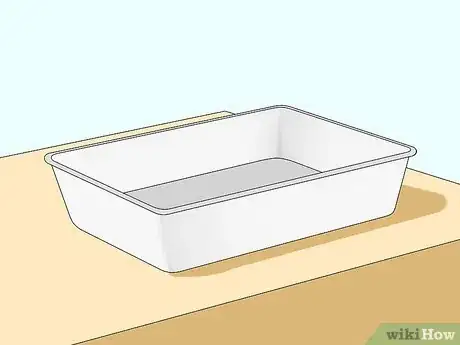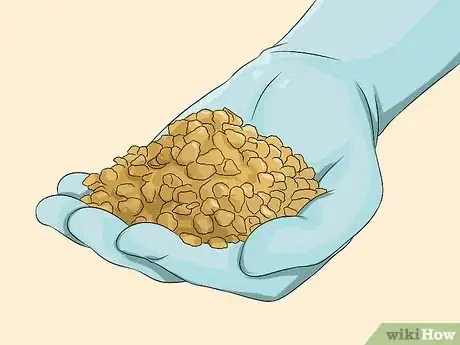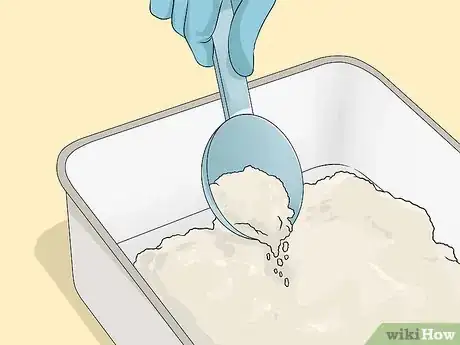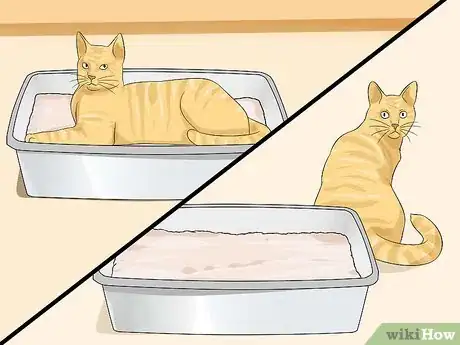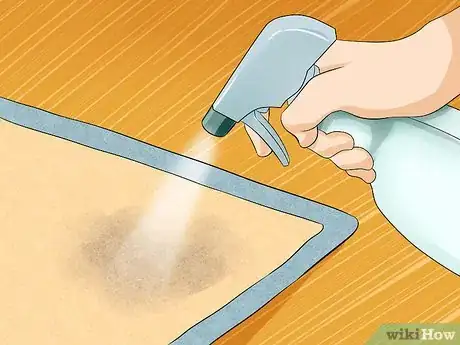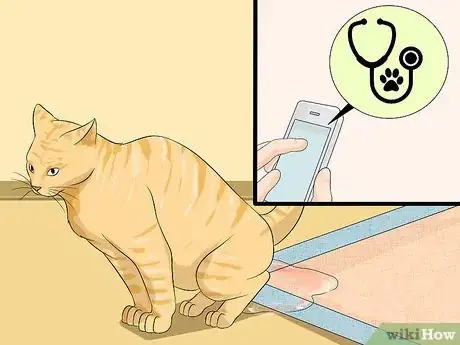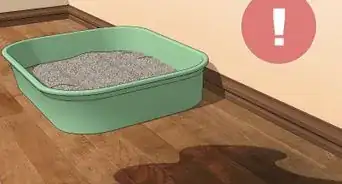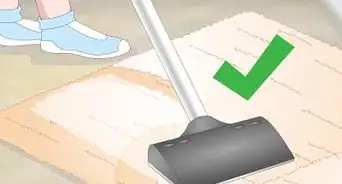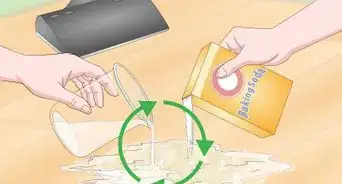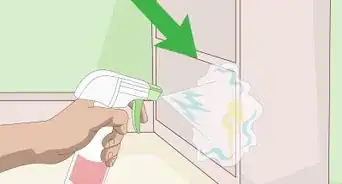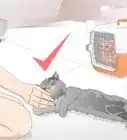This article was co-authored by Carrie Seay, MS-CABAC, KPA-CTP, CBCC-KA. Carrie Seay is a Feline Behavior Consultant and the Owner of Carrie Pawpins based in Phoenix, Arizona. With over a decade of experience, she specializes in working with cat owners to prevent and eliminate cat behavioral issues. Carrie holds a Bachelor’s degree in Biology from Northern Arizona University and a Master’s degree in Companion Animal Behavior Analysis & Counseling from The American College of Applied Science. She has multiple certifications from well-known training programs like Karen Pryor academy.
There are 11 references cited in this article, which can be found at the bottom of the page.
wikiHow marks an article as reader-approved once it receives enough positive feedback. This article received 11 testimonials and 91% of readers who voted found it helpful, earning it our reader-approved status.
This article has been viewed 440,522 times.
Cats are great companions, and they can be a lot of fun. A cat won't need to be walked like a dog, but he will need a clean litter box available at all times. If you don't keep the litter box clean, there's a chance your cat may begin relieving himself on rugs or furniture. In fact, a dirty litter box is one of the most common causes of cats eliminating outside the box.[1] Some daily maintenance is necessary to keep the box appealing to your cat, and you'll need to do a thorough cleaning about once every week (more frequently if you have more than one cat). Learning how to keep your cat's litter box clean will help ensure that your furniture remains unsoiled and your cat remains happy.
Steps
Performing Daily Litter Box Maintenance
-
1Set up a trash can close by. If you don't want to use a whole trash can, you can use an empty bucket or an empty cat litter container, and make it a designated cat waste can. It's important that you remember to set up the trash receptacle close to the litter box, so that you don't risk scattering waste or litter across the floor.[2]
-
2Wear disposable gloves and consider wearing a mask. Some experts recommend wearing disposable gloves and a dust mask to prevent the spread of toxoplasmosis, a coccidial organism that some cats carry and transmit through fecal matter.[3] Even if you don't directly handle the feces, cleaning the litter box can cause dust to fly in the air, which can irritate the lungs and may lead to transmission of toxoplasmosis.Advertisement
-
3Scoop out solids. Cat feces should be scooped out at least once every day.[4] Some experts even recommend scooping out solid wastes twice a day for a really clean box.[5] If you let solid wastes build up in the litter box, your cat may refuse to use the litter box, even if the litter was only changed a few days ago.
- Use a special scooper, available at most pet stores. These scoopers have a grated bottom, so you can collect solid waste while the surrounding litter falls through the grates and back into the litter box.
-
4Scoop out urine clumps. If you use clumping litter, your cat's urine should form solid clumps of litter. These should be scooped on a daily basis, just like feces.[6] If you don't use clumping litter, sprinkle a layer of baking soda at the bottom of the litter box, before you pour in the litter. This can help absorb the odors from cat urine that might get missed during daily scooping.[7]
-
5Replace any lost litter. If you're scooping the box out on a daily basis, there's a chance you might have lost some of the litter, either because it stuck to your cat's waste or because it simply spilled out during cleaning or use. Topping off your cat's litter every few days can help keep the box clean and appealing to your cat.
Cleaning Your Cat's Litter Box Weekly
-
1Empty out the old litter. While scooping will do on a day-to-day basis, you'll need to completely empty the litter and scrub the box at least once every week. Some cat owners may have to clean the litter box 2 or more times each week if there are multiple cats using the same litter box.[8] Keep a waste basket or trash bag close by, and dump everything out of the litter box before cleaning it.[9]
-
2Scrub the empty litter box. Once the litter is removed, you'll need to scrub the litter box, either in a sink or with a hose outside.[10] Some experts recommend scrubbing the box at least once every week, while other experts recommend scrubbing at least once each month.[11] How often you wash your cat's litter box will depend on how many cats use the box and what kind of litter you use.
- Use warm water and a mild detergent, like dish soap, that won't leave any harsh chemical smells or residue behind.[12]
- You can make an effective cleaning agent by scrubbing baking soda and a little warm water on all inside surfaces of the litter box.[13]
- Make sure that you rinse away all of the soap. Your cat may not use the box if it smells like soap or detergent.[14]
- Note that any cleaning agents that smell like ammonia or citrus will repel cats.[15] Using a cleaning agent with these smells may result in your cat being reluctant to use the litter box after you've cleaned it.[16]
-
3Dry the litter box thoroughly. It's important to ensure that the box is completely dry before you add new litter, as the litter will stick to the wet sides and bottom of the box. If you use clumping litter and fail to dry the box, it might even render the whole box full of litter unusable. You can let the box air dry, or use paper towels or napkins to wipe the box dry.[17]
-
4Consider adding baking soda. Some experts recommend sprinkling a thin layer of baking soda on the bottom of the box, before pouring on the clean litter. This can help absorb smells, and may help absorb some of the urine, if you don't use clumping litter.[18]
-
5Choose the right litter. Cats generally prefer clumping litter over non-clumping litter. Most cats find that it's more comfortable to walk on clumping litter because it's made of finer-grained material, and it's generally easier for your cat to bury his waste in. Plus, clumping litter will make it much easier for you to keep the litter box clean.[19] However, some cats do prefer traditional, non-clumping clay litter. Take note of what your cat seems to prefer, and try to cater to his choice in litter.[20]
- Do not use a clumping litter if you have a kitten. The curious kitten may investigate the litter with their mouth and accidentally swallow some. Clumping litter can cause a dangerous bowel obstruction in your kitten's intestines, requiring emergency care.
- The Humane Society cautions against using litter with perfume or deodorizer added to it, as this may irritate your cat or trigger an allergic reaction. If odor is a concern, adding baking soda to the litter box is a safe, odor-absorbing alternative to scented litter.[21]
-
6Pour in clean litter. Once the box is completely dry, you'll need to refill the litter.[22] However, you'll want to be sure to add the correct amount of litter. Too much litter will make a mess when your cat steps in and out of the box, and some cats (especially long-haired cats) are actually reluctant to use a box that is too full of litter.[23] But using too little litter can make your cat feel like he won't be able to bury his waste, which can lead to out-of-box elimination. Insufficient litter can also lead to odor problems in your home.[24]
- Most cats only need about 2 inches (5.1 cm) of litter.[25] Don't pour more than 4 inches (10 cm) of litter, or your cat may not use the box.[26]
- Whatever depth you choose to use, be consistent. Your cat may become stressed or confused if he suddenly has a lot more or less litter than he's used to.[27]
Addressing Elimination Problems
-
1Learn your cat's preferences. If your cat is eliminating outside the box, he may not like something about his litter box situation. Whether it's the wrong kind of litter, the wrong depth of litter, an unclean litter box, or even a poorly placed litter box, your cat may be trying to send you a message.[28]
- If your cat doesn't like traditional clay litter, try a clumping litter. If he doesn't like scented litter, try unscented litter. With a little trial and error, you'll be able to figure out your cat's preferences.[29]
- Be sure your cat's litter box is in a quiet, low-traffic area. If there's a lot of noise, like in a laundry room, or a lot of traffic coming through, like your home's living room, your cat may become reluctant to use the litter box. Choose a place that's quiet and relatively undisturbed, but not so undisturbed that your cat has to make a long journey through the house to get there.[30]
-
2Clean out-of-box waste thoroughly. Use an enzyme-based cleaning product to treat any household furniture or carpeting that your cat has eliminated on. This will break down any residual odor on the furniture, ensuring that your cat won't come to see it as an acceptable place to relieve himself.[31] If your cat leaves solid waste on the floor or on any furniture, use a paper towel to move the feces to his litter box, rather than throwing it in the trash. This will help remind him to use the litter box next time.[32]
-
3Keep track of your cat's bathroom habits. If your cat isn't using the litter box, it's important to check around the house to look for out-of-box elimination. If he isn't urinating anywhere, it's a sign that he may have a urinary tract infection, bladder/kidney stones, or a partially- or fully-blocked urethra. If you believe your cat is not eliminating, or if he is eliminating with blood in his urine or stool, take him to a veterinary emergency clinic immediately.[33]
- This is another reason why it's a good idea to scoop the box on a daily basis. Scooping your cat's waste allows you to monitor his health, as you'll see signs of digestive or urinary problems right away and be able to act fast.[34]
Expert Q&A
-
QuestionHow often should you change out all the kitty litter?
 Pippa Elliott, MRCVSDr. Elliott, BVMS, MRCVS is a veterinarian with over 30 years of experience in veterinary surgery and companion animal practice. She graduated from the University of Glasgow in 1987 with a degree in veterinary medicine and surgery. She has worked at the same animal clinic in her hometown for over 20 years.
Pippa Elliott, MRCVSDr. Elliott, BVMS, MRCVS is a veterinarian with over 30 years of experience in veterinary surgery and companion animal practice. She graduated from the University of Glasgow in 1987 with a degree in veterinary medicine and surgery. She has worked at the same animal clinic in her hometown for over 20 years.
Veterinarian Once a week for a full tray clean is best. This keeps the box smelling fresh so that it's a pleasant place for the cat to visit (and don't forget to spot clean daily).
Once a week for a full tray clean is best. This keeps the box smelling fresh so that it's a pleasant place for the cat to visit (and don't forget to spot clean daily). -
QuestionMy cat poops inside the box, but on the side. What can I do?
 Pippa Elliott, MRCVSDr. Elliott, BVMS, MRCVS is a veterinarian with over 30 years of experience in veterinary surgery and companion animal practice. She graduated from the University of Glasgow in 1987 with a degree in veterinary medicine and surgery. She has worked at the same animal clinic in her hometown for over 20 years.
Pippa Elliott, MRCVSDr. Elliott, BVMS, MRCVS is a veterinarian with over 30 years of experience in veterinary surgery and companion animal practice. She graduated from the University of Glasgow in 1987 with a degree in veterinary medicine and surgery. She has worked at the same animal clinic in her hometown for over 20 years.
Veterinarian This may be the size of the litter box. When the cat squats, its butt may be against the side. Look into getting a larger box so it has more room to squat down.
This may be the size of the litter box. When the cat squats, its butt may be against the side. Look into getting a larger box so it has more room to squat down. -
QuestionCan you flush cat litter?
 Pippa Elliott, MRCVSDr. Elliott, BVMS, MRCVS is a veterinarian with over 30 years of experience in veterinary surgery and companion animal practice. She graduated from the University of Glasgow in 1987 with a degree in veterinary medicine and surgery. She has worked at the same animal clinic in her hometown for over 20 years.
Pippa Elliott, MRCVSDr. Elliott, BVMS, MRCVS is a veterinarian with over 30 years of experience in veterinary surgery and companion animal practice. She graduated from the University of Glasgow in 1987 with a degree in veterinary medicine and surgery. She has worked at the same animal clinic in her hometown for over 20 years.
Veterinarian Sadly, no. It doesn't flush well and can build up in either the toilet pan or the draining sewers.
Sadly, no. It doesn't flush well and can build up in either the toilet pan or the draining sewers.
Warnings
- Never let a pregnant woman handle cat waste or clean a cat's litter box.⧼thumbs_response⧽
- Cats can transmit toxoplasmosis to humans. Consider wearing gloves and a face mask when cleaning the litter box.⧼thumbs_response⧽
- Don't use harsh chemicals when cleaning the litter box such as ammonia, bleach, or other strong scents. They can cause serious harm to your cat as well as cause it to avoid using the litter box.⧼thumbs_response⧽
Things You'll Need
- A brush or sponge for scrubbing
- Mild dish soap
- Baking soda
- A waste bin
- A litter scoop
- Fresh litter
- Disposable Gloves
References
- ↑ http://www.humanesociety.org/animals/cats/tips/solving_litter_box_problems.html
- ↑ http://www.pethealthnetwork.com/cat-health/cat-behavior/how-often-do-i-really-need-clean-my-cats-litter-box/page/0/1
- ↑ http://www.animalplanet.com/pets/how-to-safely-clean-cat-ltter-box/
- ↑ http://www.humanesociety.org/animals/cats/tips/preventing_litter_box_problems.html
- ↑ http://www.catbehaviorassociates.com/how-often-should-you-scoop-the-litter-box/
- ↑ http://www.animalplanet.com/pets/how-to-safely-clean-cat-ltter-box/
- ↑ http://www.humanesociety.org/animals/cats/tips/preventing_litter_box_problems.html
- ↑ http://www.humanesociety.org/animals/cats/tips/preventing_litter_box_problems.html
- ↑ http://www.pethealthnetwork.com/cat-health/cat-behavior/how-often-do-i-really-need-clean-my-cats-litter-box/page/0/1
- ↑ Carrie Seay, MS-CABAC, KPA-CTP, CBCC-KA. Feline Behavior Consultant. Expert Interview. 1 March 2022.
- ↑ http://www.catbehaviorassociates.com/how-much-litter-to-put-in-the-litter-box/
- ↑ http://www.humanesociety.org/animals/cats/tips/preventing_litter_box_problems.html
- ↑ https://www.aspca.org/pet-care/virtual-pet-behaviorist/cat-behavior/litter-box-problems
- ↑ http://www.animalplanet.com/pets/how-to-safely-clean-cat-ltter-box/
- ↑ Carrie Seay, MS-CABAC, KPA-CTP, CBCC-KA. Feline Behavior Consultant. Expert Interview. 1 March 2022.
- ↑ http://www.humanesociety.org/animals/cats/tips/preventing_litter_box_problems.html
- ↑ http://www.animalplanet.com/pets/how-to-safely-clean-cat-ltter-box/
- ↑ http://www.humanesociety.org/animals/cats/tips/preventing_litter_box_problems.html
- ↑ http://www.catinfo.org/?link=litterbox
- ↑ http://www.humanesociety.org/animals/cats/tips/preventing_litter_box_problems.html
- ↑ http://www.animalhumanesociety.org/training/litter-box-101-preventing-and-solving-litter-box-problems
- ↑ Carrie Seay, MS-CABAC, KPA-CTP, CBCC-KA. Feline Behavior Consultant. Expert Interview. 1 March 2022.
- ↑ http://www.humanesociety.org/animals/cats/tips/preventing_litter_box_problems.html
- ↑ http://www.catbehaviorassociates.com/how-much-litter-to-put-in-the-litter-box/
- ↑ http://www.humanesociety.org/animals/cats/tips/preventing_litter_box_problems.html
- ↑ http://www.catbehaviorassociates.com/how-much-litter-to-put-in-the-litter-box/
- ↑ http://www.catbehaviorassociates.com/how-much-litter-to-put-in-the-litter-box/
- ↑ https://www.aspca.org/pet-care/virtual-pet-behaviorist/cat-behavior/litter-box-problems
- ↑ https://www.aspca.org/pet-care/virtual-pet-behaviorist/cat-behavior/litter-box-problems
- ↑ https://www.aspca.org/pet-care/virtual-pet-behaviorist/cat-behavior/litter-box-problems
- ↑ http://www.animalhumanesociety.org/training/litter-box-101-preventing-and-solving-litter-box-problems
- ↑ http://www.catbehaviorassociates.com/kitten-litter-box-training/
- ↑ http://www.catinfo.org/?link=litterbox
- ↑ http://www.catbehaviorassociates.com/how-often-should-you-scoop-the-litter-box/
About This Article
To clean a litter box, start by scooping out solid waste from the box every day using a scooper with a grated bottom. Next, use the same scooper to remove clumps of urine from the litter. When you’ve removed all the waste, replace any litter that was lost while cleaning the box. Then, once a week, empty out the entire box of litter into the garbage and scrub the empty box with warm water and mild dish soap. Finally, rinse the soap off and let the box dry completely before adding new litter. For tips from our Veterinary reviewer on how to keep your litter box smelling fresh between cleanings, read on!
